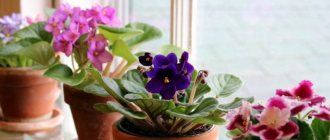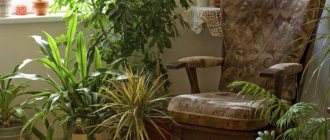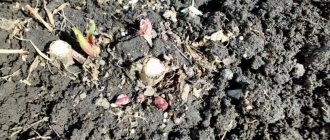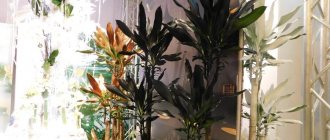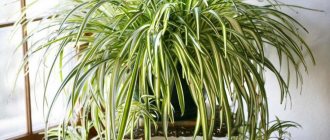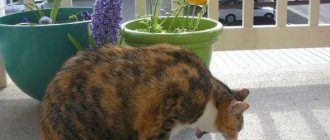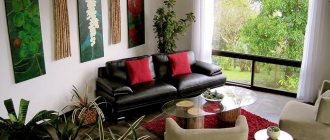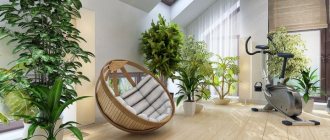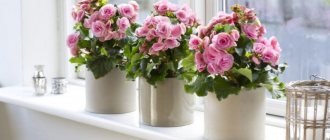Corokia cotoneaster
One of the most interesting house plants. It has tangled dense branches and at the same time an almost transparent crown. The height of the bush is from 30 to 80 cm, it can easily be given any shape.
The small, yellow, star-shaped flowers smell pleasant. Corokia loves bright light, cool temperatures, and moderate watering.
The zigzag growing branches create an unusual tangled lace appearance.
This exotic specimen prefers cool weather, especially during wintering. In summer it needs to be taken out into the fresh air more often.
Classification of decorative foliage plants by illumination
Most decorative leafy houseplants do not tolerate direct sunlight. Among these crops, some like strong light, others do not. There are species that are equally well adapted to lighting conditions, for example, Zamioculcas.
Photophilous
Very fashionable deciduous indoor plants, ctenants, are light-loving, but diffused light is required for their foliage to be highly decorative. These are dizygotheca and dieffenbachia.
Ktenanta
Shade-tolerant
Shade-tolerant species include Dracaena marginalata, fragrant and other species. They can be placed in the middle of a room with windows in a western or southern location.
Pteris Cretan
An unusually beautiful species of fern, often grown at home. Despite its sophistication, it is unpretentious in care and is a godsend for beginning gardeners.
Pteris leaves are shaped like feathers. Their colors are very beautiful: a white vein in the middle and green edges. The plant loves diffused lighting; shade and bright sunlight are equally destructive to delicate foliage.
Pteris needs a stable, slightly cool temperature of +20…+22°C. The substrate in the pot is kept sufficiently moist, but water does not stagnate.
Precious Crassula Crassula lace
Crassulas, or Crassulas, are associated with boring and familiar succulents - the money tree and other species with “regular” fleshy leaves. But the Crassula genus is so vast that unexpected surprises can be found among its representatives. One of the most unusual plants of this genus, its lace effect can compete with even the best ground covers. And so reminiscent in its appearance of luxurious necklaces, the plant literally transforms during flowering.
Rock Crassula, or Crassula rupestris. © Wayne Fagerlund
Openwork indoor plants Crassula rupestris - not the most popular of the Crassula plants, but definitely the most openwork. Fleshy, shortened, with a reddish edge, small leaves with a matte edge are located on creeping shoots amazingly densely and from a distance resemble pearls in a string of beads.
Raised or low-lying, numerous straight shoots with a woody base that becomes exposed over time create striking subshrubs, as if frozen precious lace or sculptures.
The illusion of an unusual ornament is enhanced by the pairwise arrangement of leaves fused at the base. The tips of the shoots look like roses or green flowers. The effect of an openwork crown is even more enhanced in the varieties of rock crassula - the already legendary “Hottentot” and “Isabelle”, in which the pattern of pairs of leaves on the shoots is especially interesting, and the color is more than saturated.
But the real lace show begins in this species of Crassula only when the inflorescences appear. White or pink miniature flowers of a very beautiful five-petal shape are collected in loose umbrellas of inflorescences and, as if a luxurious weightless lace, shine above their already delightfully patterned crown of this plant. Flowering in varietal crassulas can last for several months.
Rock Crassula is one of the few representatives of ampelous Crassulas. In nature, the beauty is found on the mountain slopes of southern Africa. In indoor culture, it completely retains its southern “habits”, but also requires the same light soil (a mixture for cacti is best suited).
Despite its filigree beauty, this fat woman is very hardy. This is one of the easiest species to grow, pleasantly surprising with its undemandingness and drought resistance. But for rock crassula it is worth providing the most intense lighting - a bright sunny or diffused sunny place. This species feels best in southern locations.
In order for Crassula to bloom next year, it must be kept cool in winter. But the rest of the year she will put up with any heat.
Rock Crassula, or Crassula rupestris. © Boeta rumbling
Features of caring for Crassula rock:
- requires moderate watering in the cold season and abundant watering during the active growing season, but the soil must be allowed to dry out between procedures;
- fertilizing is carried out very carefully, in reduced doses and less often than usual;
- allows for formation.
Crassula rock feels great both as a potted and hanging plant. Over time, the bottom of the shoots becomes woody and bare, but this does not spoil the appearance of the dense bushes, but seems to lift the openwork cloud of the crown. This fat girl also looks better as a proud soloist. It is able to effectively decorate large empty surfaces and does not get lost even in the kitchen with a large accumulation of parts and household items.
Nephrolepis
One of the most popular types of ferns. Huge feathery leaves look impressive both in ampelous compositions and alone. Nephrolepis can be grown as an epiphyte. The pots need to be wide and low, since its root system is small.
The fern with curled, wavy, carved leaves looks original. The culture loves diffused sunlight, fresh air without drafts. In summer, the plant can be taken outside.
Growing nephrolepis is not difficult, but you need to remember that it needs high humidity. To achieve this, it is often sprayed, in hot weather even more than once a day.
How to propagate monstera?
Indoor liana reproduces in three ways:
- by air layering - this is the easiest way of propagation; layering with at least one leaf plate and an aerial root is suitable for it; they are lowered into the ground to form an independent plant; they can be temporarily placed in plastic bottles to form roots;
- by cuttings - the use of lateral and stem shoots as material is practiced, the cuttings are rooted in pots under a glass greenhouse; before roots appear, the glass is lifted, ventilated and watered twice a day, and then transplanted into a larger pot;
- seed method - pots with sown seeds must always be kept warm and receive sufficient light. The first shoots appear after about 30 days. By the age of two years, an average of 9 leaves can be counted on a plant.
How does it bloom?
The flowering of vines with large white flowers occurs mainly in the natural environment; the flowers look like the sails of a yacht or the cap of a small gnome. Corn-cob-like fruits then appear, which turn purple when fully ripe. In the delicious monstera, these fruits are suitable for consumption.
The monstera plant blooms, extremely rarely, flowers appear in greenhouses and winter gardens. When grown at home, it is almost impossible to observe exotic flowering.
Selaginella
A perennial ground cover plant from the genus Mocopod with very original leaves reminiscent of soft coniferous twigs. The shape of the leaves can be needle-shaped, round, spiral.
The colors are also varied: light green, yellowish, dark green and even almost black with a metallic sheen.
Lacy greenery grows very quickly, forming an intricate pattern. She needs diffused light and good moisture. Heat is destructive for club mosses - the plant withers, sheds its leaves and may even die.
Davallia
A lush epiphytic fern that seems weightless due to its beautiful filigree greenery. Its thick leaves are pinnately dissected, like those of garden fern species.
It grows very quickly, its roots literally crawl out of the container in which it is planted.
Davallia is unpretentious and loves sunlight. She needs infrequent but abundant watering. You can wash the flower in the shower, avoiding water getting on the soil and roots.
Main types of leaves
The simplest classification of plant leaves is based on their shape. According to it, there are leaf-shaped processes (for example, in ferns), leaves of flowering plants (the classic form with a petiole and a leaf blade), needles and involucre leaves (common in herbs).
Species identified by location on the stem
Alternate or sequential arrangement means that leaves begin to grow on the stem, one at each node. The term “node” refers to the place on the stem that is used for the formation of a new leaf.
Opposite arrangement means that two leaves grow at each node of the branch or stem. Moreover, in many cases, each subsequent node is rotated 90 degrees relative to the previous one.
Rosette placement of leaves implies their location at the same height and orientation in a circle. Roughly speaking, all the leaves of such a plant grow from one point (the root) and form a beautiful spreading bush.
There is also a whorled arrangement. It is similar to the opposite, but has three leaves per node. In this case, the nodes are called whorls and can also be successively rotated 90 degrees.
Maidenhair
One of the most beautiful openwork indoor plants. Its graceful shoots add freshness to the room. Adiantum is demanding on lighting, watering and temperature. It needs to be sprayed daily with a spray bottle and ensure that the substrate in the pot is moist.
The plant does not tolerate heat and thrives in partial shade. The fern does not tolerate drafts and tobacco smoke. Adiantum is periodically pruned, removing old dried branches.
Decorative foliage indoor plants
Plants with intricately colored or cut leaves mostly come from hot countries with tropical and subtropical climates. It is advisable to grow perennials at home. They bloom rarely, usually 5 or more years after planting. The flowers are often inconspicuous and small. The seeds are formed rarely, take a long time to ripen, are colored black, and have a hard shell.
Miniature garden of decorative foliage succulents
Note! The list of decorative crops for homes and offices, which are used by professional design and landscaping specialists, is constantly updated with new varieties and rare names.
Classification of indoor plants
Depending on their life form, decorative deciduous crops are divided into:
- herbs;
- shrubs, shrubs and subshrubs;
- trees.
For your information! The main difference between shrubs and trees and herbs is the presence of a stem and trunk, which can be covered with crust or not.
Herbaceous plants, in turn, are divided into leafy, leafy, and climbing. In addition, plants are grouped in relation to environmental factors, belonging to groups and species with a characteristic structure of leaves and shoots.
Appearance and leaves of decorative foliage plants
Aesthetic qualities are formed by the following characteristics of leaves:
- shape and thickness;
- degree of dissection;
- coloring;
- the nature of the surface is glossy or matte.
In addition, designers combine decorative foliage plants with drooping or erect rosettes.

